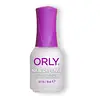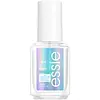What's inside
What's inside
 Key Ingredients
Key Ingredients

 Benefits
Benefits

 Concerns
Concerns

 Ingredients Side-by-side
Ingredients Side-by-side

Ethyl Acetate
PerfumingButyl Acetate
MaskingAlcohol Denat.
AntimicrobialNitrocellulose
Adipic Acid/Neopentyl Glycol/Trimellitic Anhydride Copolymer
Isopropyl Alcohol
SolventTrimethyl Pentanyl Diisobutyrate
Acetyl Tributyl Citrate
MaskingSucrose Acetate Isobutyrate
Benzophenone-1
UV AbsorberEtocrylene
UV AbsorberEpoxidized Soybean Oil
EmollientPolyvinyl Butyral
Hydrolyzed Wheat Protein
Skin ConditioningTocopheryl Acetate
AntioxidantCarthamus Tinctorius Seed Oil
MaskingMelilotus Officinalis Extract
AstringentChamomilla Recutita Flower Extract
MaskingEquisetum Hyemale Leaf/Stem Extract
Skin ConditioningWater
Skin ConditioningDimethicone
EmollientCalcium Pantothenate
CI 60725
Cosmetic ColorantEthyl Acetate, Butyl Acetate, Alcohol Denat., Nitrocellulose, Adipic Acid/Neopentyl Glycol/Trimellitic Anhydride Copolymer, Isopropyl Alcohol, Trimethyl Pentanyl Diisobutyrate, Acetyl Tributyl Citrate, Sucrose Acetate Isobutyrate, Benzophenone-1, Etocrylene, Epoxidized Soybean Oil, Polyvinyl Butyral, Hydrolyzed Wheat Protein, Tocopheryl Acetate, Carthamus Tinctorius Seed Oil, Melilotus Officinalis Extract, Chamomilla Recutita Flower Extract, Equisetum Hyemale Leaf/Stem Extract, Water, Dimethicone, Calcium Pantothenate, CI 60725
Ethyl Acetate
PerfumingButyl Acetate
MaskingNitrocellulose
Propyl Acetate
PerfumingTributyl Citrate
SolventIsopropyl Alcohol
SolventTosylamide/Epoxy Resin
Adipic Acid/Neopentyl Glycol/Trimellitic Anhydride Copolymer
Stearalkonium Hectorite
Gel FormingAcrylates Copolymer
Benzophenone-1
UV AbsorberDimethyl Sulfone
SolventCalcium Sodium Borosilicate
Synthetic Fluorphlogopite
Hydrogenated Acetophenone/Oxymethylene Copolymer
Dimethicone
EmollientCitric Acid
BufferingOxidized Polyethylene
Acetyl Tributyl Citrate
MaskingCI 77120
Cosmetic ColorantAlumina
AbrasiveCalcium Aluminum Borosilicate
Colophonium
Silica
AbrasiveWater
Skin ConditioningTin Oxide
AbrasiveMagnesium Silicate
AbsorbentCalcium Pantothenate
Camellia Sinensis Leaf Extract
AntimicrobialAluminum Hydroxide
EmollientPhthalic Anhydride/Glycerin/Glycidyl Decanoate Copolymer
Acetone
SolventCI 77002
Cosmetic ColorantCI 77891
Cosmetic ColorantMica
Cosmetic ColorantCI 77491
Cosmetic ColorantCI 77499
Cosmetic ColorantCI 15880
Cosmetic ColorantCI 19140
Cosmetic ColorantCI 15850
Cosmetic ColorantCI 77400
Cosmetic ColorantCI 77288
Cosmetic ColorantCI 42090
Cosmetic ColorantCI 77510
Cosmetic ColorantCI 77000
Cosmetic ColorantCI 77163
Cosmetic ColorantCI 77266
Cosmetic ColorantEthyl Acetate, Butyl Acetate, Nitrocellulose, Propyl Acetate, Tributyl Citrate, Isopropyl Alcohol, Tosylamide/Epoxy Resin, Adipic Acid/Neopentyl Glycol/Trimellitic Anhydride Copolymer, Stearalkonium Hectorite, Acrylates Copolymer, Benzophenone-1, Dimethyl Sulfone, Calcium Sodium Borosilicate, Synthetic Fluorphlogopite, Hydrogenated Acetophenone/Oxymethylene Copolymer, Dimethicone, Citric Acid, Oxidized Polyethylene, Acetyl Tributyl Citrate, CI 77120, Alumina, Calcium Aluminum Borosilicate, Colophonium, Silica, Water, Tin Oxide, Magnesium Silicate, Calcium Pantothenate, Camellia Sinensis Leaf Extract, Aluminum Hydroxide, Phthalic Anhydride/Glycerin/Glycidyl Decanoate Copolymer, Acetone, CI 77002, CI 77891, Mica, CI 77491, CI 77499, CI 15880, CI 19140, CI 15850, CI 77400, CI 77288, CI 42090, CI 77510, CI 77000, CI 77163, CI 77266
Ingredients Explained
These ingredients are found in both products.
Ingredients higher up in an ingredient list are typically present in a larger amount.
Acetyl Tributyl Citrate is a fragrance.
We don't have a description for Adipic Acid/Neopentyl Glycol/Trimellitic Anhydride Copolymer yet.
Benzophenone-1 absorbs UV.
We don't have a description for Butyl Acetate yet.
Calcium Pantothenate is calcium salt from Vitamin B5. It can be naturally found in plants and animals.
Calcium Pantothenate is a potent antioxidant. Antioxidants help fight free-radical molecules. Free-radical molecules are capable of damaging our cells and other genetic material. Antioxidants help stabilize free-radicals by donating extra electrons. This may help reduce the signs of aging.
Our bodies use Calcium Pantothenate for various metabolic functinos. These functions include metabolizing carbohydrates, proteins, and fatty acids.
Learn more about Calcium PantothenateDimethicone is a type of synthetic silicone created from natural materials such as quartz.
What it does:
Dimethicone comes in different viscosities:
Depending on the viscosity, dimethicone has different properties.
Ingredients lists don't always show which type is used, so we recommend reaching out to the brand if you have questions about the viscosity.
This ingredient is unlikely to cause irritation because it does not get absorbed into skin. However, people with silicone allergies should be careful about using this ingredient.
Note: Dimethicone may contribute to pilling. This is because it is not oil or water soluble, so pilling may occur when layered with products. When mixed with heavy oils in a formula, the outcome is also quite greasy.
Learn more about DimethiconeEthyl Acetate is a fragrance.
Isopropyl Alcohol is more commonly known as rubbing alcohol. It is most commonly used as a solvent, meaning it helps other ingredients dissolve.
This ingredient is an astringent alcohol. Astringent alcohols may also irritate skin as they high amounts may strip away your skin's natural oils.
Other types of astringent alcohols include:
According to the National Rosacea Society based in the US, you should be mindful of products with these alcohols in the top half of ingredients.
Any type of sanitizing product will have high amounts of alcohol to help kill bacteria and viruses.
Learn more about Isopropyl AlcoholWe don't have a description for Nitrocellulose yet.
Water. It's the most common cosmetic ingredient of all. You'll usually see it at the top of ingredient lists, meaning that it makes up the largest part of the product.
So why is it so popular? Water most often acts as a solvent - this means that it helps dissolve other ingredients into the formulation.
You'll also recognize water as that liquid we all need to stay alive. If you see this, drink a glass of water. Stay hydrated!
Learn more about Water